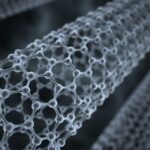
Carbon nanotubes

Carbon nanotubes
By the AVICENN team – Last updated April 2023
Different types of carbon nanotubes
Discovered two decades ago, carbon nanotubes are a new form of carbon.
There is a large variety and their physicochemical characteristics vary according to their manufacturing or implementation process.
These nano-objects are sheets of graphene wound on themselves, forming hollow cylinders, with at least two dimensions in the nanoscale.
They can be divided into two main groups:
- single-walled carbon nanotubes (SWCNT), which are made of a sheet of graphene, wound in the form of a cylindrical tube
- multi-walled carbon nanotubes (MWCNT) made up of several concentric tubes.
Their average diameter varies from a nanometer (SWCNT) to a few tens of nanometers (MWCNT), up to 100 nm.
Their length also varies from a few micrometers to a few hundred micrometers and can even reach several meters in some cases.
What are their properties?
Because of their exceptional properties – electrical conductivity, mechanical strength and thermal conductivity – carbon nanotubes have been touted as revolutionary materials for industrial sectors such as electronics, aerospace or nanomedicine.
The importance of their “length to diameter” ratio gives carbon nanotubes very specific properties, which are exploited or coveted:
- for materials (electrostatic dissipation, mechanical reinforcement)
- for coatings (electrical conductivity to adhesives and inks for example)
- for energy (extending the life of energy storage systems by allowing a greater number of charge/discharge cycles; increasing the performance of li-ion batteries)
- for catalysis
- for the medical field1Cf. Saito, N. et al. Future Prospects for Clinical Applications of Nanocarbons Focusing on Carbon Nanotubes. Advanced sciences, 2022: drug delivery, imaging and even medical devices.
Yet, at the end of 2017, the “miracles” seem to have failed to materialize and working industrial applications are rare. Carbon nanotubes are difficult to combine with other materials, or when they are, they can lose the properties for which they were made2Fine felted nanotubes CAU research team develops new composite material made of carbon nanotubes, Kiel University, November 21, 2017.
How much is on the market?
By 2016, between one and ten tons* of carbon nanotubes had been reported to the R-nano registry as having been produced and/or imported into France in 2015. However, in 2019, less than 1 kg was reported in total nationally for 2018. The declared volume increased to the 1-10 tonnes range in the 2020 and 2021 reports. This range illustrates the weight given by the public authorities to industrial and commercial secrecy, which prevents us from having a good understanding of the quantities and uses of these nanomaterials, despite the increasingly pressing requests for information from a growing number of stakeholders. Moreover, this quantity is very small compared to what was suggested by the announcements around the promises of carbon nanotubes.
Some production sites (and their difficulties)
- By 2020, the Russian group OCSiAl plans to set up the world’s largest industrial production of single-walled carbon nanotubes in Luxembourg, in the Hanebësch business park in Differdange3Cf. Nanomaterials: a 100 million euro project and 200 jobs in Differdange, Le Quotidien, July 5, 2017.
- In France, Arkema started up the first pilot laboratory capable of producing nearly 20 metric tons of carbon nanotubes per year at its Lacq site in 2006. In 2009, the company announced the construction of a carbon nanotube pilot plant at its Mont site (Pyrénées-Atlantiques)4Arkema builds a carbon nanotube pilot plant in France, Arkema, press release, September 17, 2009. With a potential capacity of 400 tons/year, the unit apparently produced only 40 tons, once, between 2011 and 2015 – “40 tons still stored on site”, according to Eric Frasca, CGT delegate of the Lacq-Mourenx site5Mont: carbon nanotubes in the crosshairs of the Sepanso, La République des Pyrénées, February 25, 2015.
- In Germany, Bayer also stopped its carbon nanotube manufacturing in 20136See in particular:
-Nanotubes de carbone : la déception gagne l’industrie, L’Usine nouvelle, 13 mai 2013
–Nanotubes de carbone : le marché sera plus restreint, selon Arkema, Industrie & Technologies, 16 mai 2013. - In Belgium, Nanocyl has an industrial pilot that is “still not profitable fifteen years after its creation”7“Nanocyl, Walloon technology flagship, is still not profitable fifteen years after its creation, RTBF, October 9, 2016..
- Asian competition could explain the difficulties of European producers (in 2013, the Chinese CNano Technology and the Japanese Showa Denko were increasingly important in the carbon nanotube market).
- In the United States, market players include Hyperion Catalysis and, more recently, the Californian start-up Saratoga Energy, which has developed a promising electrolytic process for the low-cost conversion of CO2 into carbon nanotubes (less than $5 per kilogram, or one hundred times cheaper than the current cost of producing them in the gas phase on a catalytic support)814 nominees and 3 winners at the World Materials Forum 2017 start-up challenge, L’Usine nouvelle, April 25, 2017.
What are the risks?
The intrinsic physicochemical properties of carbon nanotubes raise many concerns about their effects on human health.
In view of the harmful effects that may be caused by certain carbon nanotubes (carbon nanotubes cause damage comparable to that caused by asbestos in the lungs and pleura), a classification is underway at the European level.
In French :
- Carbone – Ses vies, ses oeuvres, Bernadette Bensaude-Vincent and Sacha Loeve, Seuil, October 2018
- The fantastic world of carbonaceous nanomaterials, Chris Ewels (Chargé de Recherche, University of Nantes), Jérémy Rio (Docteur, University of Nantes), Pint of Science, 15 May 2018
In English:
- AzoNano, Consumer Applications of Carbon Nanotubes, January 2022
- IBM Research, Carbon nanotubes push the limit of flexible electronics, March 9, 2018
Any questions or comments? This information sheet compiled by AVICENN is intended to be completed and updated. Please feel free to contribute.
Other news on the topic
Our information sheets to go further
Upcoming Nano Agenda

- E-learning program: awareness-raising for personnel who come into contact with nanomaterials during research, formulation, production, maintenance, cleaning, upkeep, etc., as well as safety coordinators or engineers, facility managers, heads of laboratories where nanoparticles are handled.
- Organizers: INSTN Grenoble (CEA)
- On the program:
- 1 – Introduction, definition and characteristics of nanomaterials
- 2 – Toxicity of nanomaterials: the state of knowledge
- 3 – Metrology and characterization of nanomaterials
- 4 – Prevention and protection against nanomaterials in the workplace
- 5 – Quiz: assessment of learning outcomes
- The 2-hour course can be viewed for one month from the date of registration.
- Website: https://instn.cea.fr/…risques-lies-aux-nanomateriaux…
- Annual conference of the NaMasTE research group (Manufactured Nanomaterials, Toxicology, Ecotoxicology and Risks: towards controlled development)
- Dates: December 9 and 10, 2025
- Organizers: CNRS
- Website: https://namaste2025.sciencesconf.org
- 8th Congress of Occupational Medicine and Health (CNMST 2026)
- Theme 5: Emerging pathologies and risks, Mr Henri Bastos (ANSES), Pr Lynda Bensefa-Colas (AP-HP), Dr Catherine Nisse (CHU Lille)
- Website: www.medecine-sante-travail.com
This sheet was originally posted in July 2017
Notes and references
- 1Cf. Saito, N. et al. Future Prospects for Clinical Applications of Nanocarbons Focusing on Carbon Nanotubes. Advanced sciences, 2022
- 2Fine felted nanotubes CAU research team develops new composite material made of carbon nanotubes, Kiel University, November 21, 2017
- 3Cf. Nanomaterials: a 100 million euro project and 200 jobs in Differdange, Le Quotidien, July 5, 2017
- 4Arkema builds a carbon nanotube pilot plant in France, Arkema, press release, September 17, 2009
- 5Mont: carbon nanotubes in the crosshairs of the Sepanso, La République des Pyrénées, February 25, 2015
- 6See in particular:
-Nanotubes de carbone : la déception gagne l’industrie, L’Usine nouvelle, 13 mai 2013
–Nanotubes de carbone : le marché sera plus restreint, selon Arkema, Industrie & Technologies, 16 mai 2013 - 7“Nanocyl, Walloon technology flagship, is still not profitable fifteen years after its creation, RTBF, October 9, 2016.
- 814 nominees and 3 winners at the World Materials Forum 2017 start-up challenge, L’Usine nouvelle, April 25, 2017



